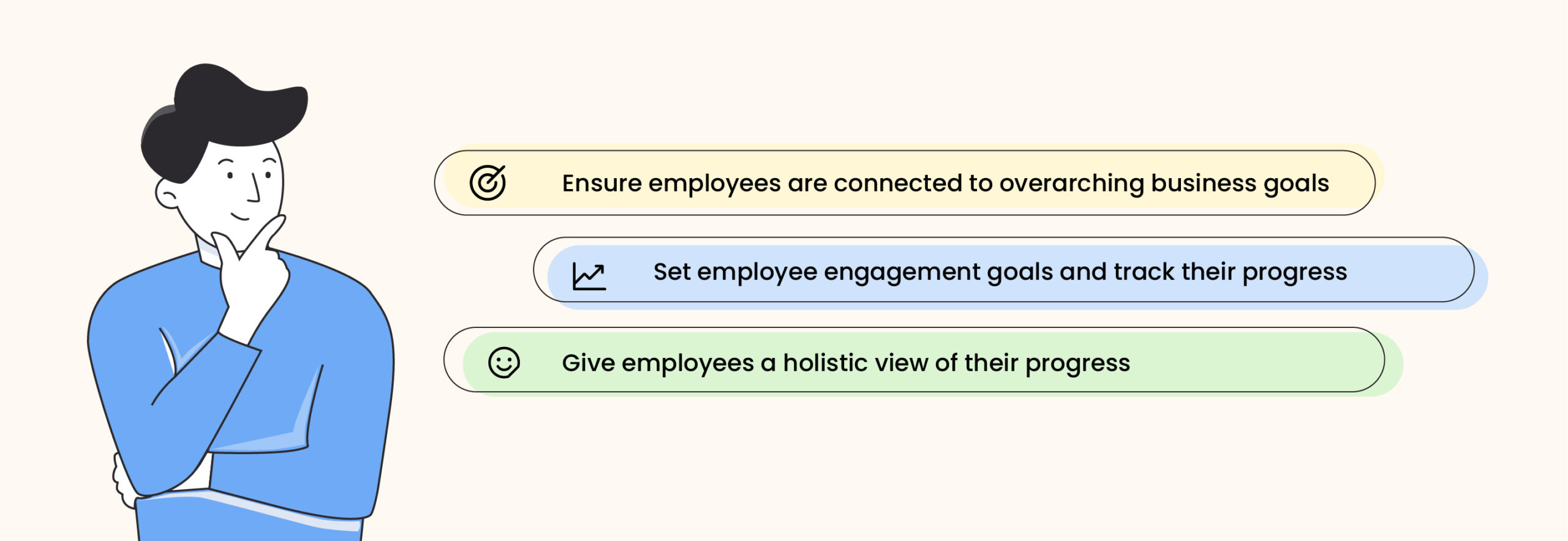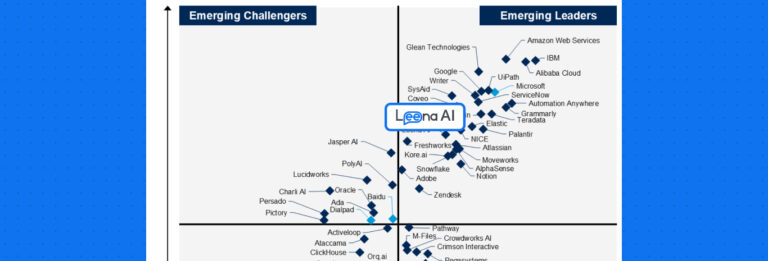Organizations are thinking about employee engagement more strategically – starting with setting clear employee engagement objectives.
Setting employee engagement objectives and tracking progress allows you to build a high-performing workforce. It also helps you identify areas of improvement and enhance employee well-being, thereby improving engagement and retention even as the company grows.
This article summarizes the scope of employee engagement, talks about the aims and objectives of employee engagement, and then deep dives into the key employee engagement objectives with the help of employee engagement objectives examples.

What is employee engagement?
Employee engagement is the level of commitment that employees display towards their job. A highly engaged employee is dedicated to their job and is a positive advocate of their employer, while a barely engaged or disengaged employee is unsatisfied with their work and exhibits higher tendencies to seek out other employers.
Why is employee engagement important?

Employee engagement is a good measure of how employees feel about their organization. Highly engaged employees love their job and always go the extra mile to drive business growth. An article on Forbes states that companies with engaged workforces outperform their competitors by 147% in earnings per share.
In addition to the above, engaged employees also become advocates for a company, attracting better talent and partnerships in the ecosystem.
What are the different types of employee engagement?
| Actively engaged employees | Not engaged employees | Actively disengaged employees |
| These employees are entirely committed to their work and emotionally connected to the organization. They are eager to learn and bring out new ideas and experiments. Actively engaged employees are consistently high performers and are pretty proactive. | These employees view their jobs as the source of their income. Unless they see a compelling reason, such employees rarely go above and beyond to contribute to their organization. They are neutral in how they perceive their workplace. | The employees in this category are highly unsatisfied with their jobs. They may harbor negative sentiments about their organization and are highly likely to leave. They are unlikely to invest enough time and effort to fuel their career and can be pretty vocal about their opinions. |
What are the key drivers of employee engagement?

There are plenty of factors that can influence your employees and drive their level of engagement. Here are the seven primary drivers of employee engagement:
-
- Leadership – The approachability, integrity and transparency shown by the leadership of the organization towards business goals and collaborations.
- Manager – The communication, collaboration, feedback and recognition efforts a manager puts into the team to build trust.
- Growth – The opportunity, autonomy and freedom to innovate and be creative at work.
- Team – The camaraderie and trust amongst members of the same team or department and how they communicate to collaborate.
- Organization – The communicated vision and mission of the organization, the work culture, diversity, equity and inclusion at the workplace.
- Work – The compensation, benefits, upskill opportunities, resources and work-life balance provided to the employees.
- Satisfaction – The happiness and satisfaction levels at work and the overall sentiment around working for the organization.
Now that you know the importance of employee engagement and what drives it, let’s look at how you can tie it to business objectives.
How to set business objectives for employee engagement?

Here are three ways to ensure that your employee engagement strategy is aligned with the overall business objectives:
1. Ensure employees are connected to overarching business goals
To increase employee engagement levels, employees must be deeply aware of the company’s goals and how they can drive business growth. This is a delicate process that needs to be meticulously managed with proper communication by senior leadership (CXOs) and managers
The first step is to communicate the business goals to employees and help them understand the significance of these goals.
The second step is to tie the aims and objectives of employee engagement with the organization’s goals. Essentially, managers must break down daily, weekly, and monthly tasks assigned to employees and show them how their contributions are linked to the overall business goals.
Regular communication between employees and their managers is vital, and it needs to happen periodically to ensure that employees stay aligned.
2. Set employee engagement goals and track their progress
Once your employees know their roles in driving business growth, the next step is to set targeted goals for them. Setting such goals will help your employees better orient themselves and work systematically.
Ensure that you set SMART goals to keep things aligned and streamlined:
- Specific – What exactly do you want them to achieve?
- Measurable – How will you/ them know when the goal is achieved?
- Attainable – Is it genuinely possible to achieve the set goal?
- Relevant – Does it contribute to the business goals and objectives?
- Time-bound – When do you want to achieve the goal?
Of course, setting goals is just part of the process. To truly understand the scope of employee engagement, you need to constantly measure your employees’ progress with respect to the defined goals.
A regular review meeting every three months or even twice a year is essential to ensure that employees are understanding challenges and hitting their targets.
3. Give employees a holistic view of their progress
Reviews from subordinates, managers, and colleagues go a long way in helping you track employee performance without any managerial bias. It gives you a glimpse into how your employee is doing by bringing perspectives from different stakeholders.
This is essential to identify areas of improvement and fix any gaps with respect to employee engagement and business objectives. You can create performance review reports at a weekly, bi-weekly, or even monthly cadence.
13 important employee engagement objectives to focus on
As we’ve seen earlier in this article, a great way to boost business growth is clearly defining employee engagement objectives. Unless you can figure out the purpose of your employee engagement activities, all your efforts are futile.
Here are 13 critical aims and objectives of employee engagement to drive business growth and success:
 Align employees with the big picture
Align employees with the big picture
Clarity is a key employee engagement driver. Make it a priority to ensure that your employees are closely aligned with your company’s goals. Employees who understand how they contribute toward organizational goals tend to be highly engaged. This is because they are aware of the significance of their contribution.
Clear and crisp communication is critical. Similarly, it is also vital to appreciate your employees for their milestones. Quarterly employee recognition programs can go a long way in empowering your employees and motivating them to work.
 Strengthen employee-employer relationships
Strengthen employee-employer relationships
One of the first steps to creating a highly engaged workforce is understanding the importance of employee-employer relationships. Interacting with your employees and understanding how they perceive your company is essential.
It also helps to develop insights into their strengths and interests to create a flexible workplace culture. Employees should feel free to approach their seniors without feeling intimidated or fearful.
 Increase productivity
Increase productivity
A productive employee is the greatest resource a company can have. Ensure that your workplace helps your employees be productive and efficient.
It is natural for employees to experience bouts of low productivity. In such cases, try understanding what the employee needs to increase productivity. Equip employees with the right tools and technology to facilitate this, and conduct frequent pulse surveys to identify their changing requirements.
 Make the workplace better
Make the workplace better
Toxic workplace conditions can put off employees and become a roadblock for employee engagement and productivity. One of the primary employee engagement program objectives should be to create a workplace that is free from bias, respectful, and flexible.
Encourage open and transparent communication and conduct periodic surveys. The objective of an employee engagement survey should be to gather insights into the challenges your employees are facing in the workplace – for instance, an overbearing manager, miscommunications, undervaluing employee opinions, etc.
 Boost your employee’s sense of well-being
Boost your employee’s sense of well-being
Employees tend to function better in an environment that cares about their physical and mental well-being. Introducing wellness initiatives, medical leaves, etc., are a great way to support your employees. Apart from this, it also helps to provide employees with the help and support they require. Ensure that employees feel heard and offer workable solutions for their challenges.
 Improve employee performance
Improve employee performance
Highly engaged employees are 21% more profitable than the ones who aren’t. Your employee engagement programs should focus on motivating employees to perform better.
Create opportunities that excite your teams and incentivize them when they accomplish major goals or KPIs. This could be in the form of bonuses or even simple recognition at quarterly town halls.
 Improve cross-vertical communication
Improve cross-vertical communication
Employees should be free to communicate with their direct managers and other, senior stakeholders across different verticals. This way, any issues that hinder productivity can be resolved proactively. Cross-vertical communication also encourages teamwork and makes the employees feel genuinely connected to the company.
 Increase employee satisfaction
Increase employee satisfaction
Another critical objective of employee engagement should be to create a workplace that values an employee’s personal life. An excellent work-life balance increases employee satisfaction which in turn increases employee engagement.
 Motivate your employees
Motivate your employees
Employees tend to perform better when their company recognizes their efforts and milestones. Positive reinforcements such as spotlight awards, acknowledging individual contributions, etc., motivate employees and push them to perform better. This, in turn, allows businesses to perform better as well.
 Receive and offer feedback
Receive and offer feedback
Constructive feedback is vital for growth. And it is just as important to listen to the voice of your employees as it is for you to give them feedback. In addition to figuring out what worked, feedback is key to improving the employee experience – including the smallest of things like employee and organization policies.
 Attract and retain quality employees
Attract and retain quality employees
Another important employee engagement objective that is often ignored is recruiting and retaining quality talent. Offering attractive perks, creating a healthy workplace, and a culture where employees inspire each other are just the starting points. You need to continually understand changing employee expectations and enable their growth both personally and professionally.
 Equip managers with leadership skills
Equip managers with leadership skills
Often, managers at the local level are not always equipped with the skills or information needed for employee engagement. In such cases, it is necessary to provide them with training that helps them to improve their managerial skills. Good managers can nurture productive and highly engaged employees.
 Find solutions to all problems
Find solutions to all problems
Sure it seems like an ideal scenario, but employees who are confident that their employers will address an issue are more confident in their organization. This is especially true with issues or conflicts that challenge their work. Strive to find workable solutions for all problems and encourage employees to speak up about any difficulties they face – you can do this through continual feedback loops, surveys, polls and similar engagement strategies.
Ready to accomplish your employee engagement objectives?
Employee engagement is a critical factor in driving business growth. This is precisely why HR managers need to approach it strategically. Senior-level executives and stakeholders must make employee engagement a boardroom agenda and define policies and frameworks that increase employee loyalty, productivity, and performance.
Take the first step towards building your employee engagement objectives!
Schedule a demo todayFrequently Asked Questions
What are the goals of an employee engagement survey?
An employee engagement survey aims to capture employee feedback, identify areas of improvement, and understand what’s working and why. It also helps companies figure out actionable strategies and incorporate them for a better employee experience.
What are the objectives of employee involvement and participation?
The objectives of employee involvement and participation are to:
- Encourage seamless communication between all levels of an organization
- Induce a sense of belonging and commitment among employees
- Encourage strong employer-employee relationships
- Encourage ownership among employees
What are the objectives of employee satisfaction?
The objectives of employee satisfaction include:
- Increase employee productivity
- Better employee retention
- Nurture happier employees
- Encourage professional growth
- Understand how employees perceive the organization
- Improve overall company performance
What are the objectives of employee motivation?
The objectives of employee motivation are to:
- Build a highly productive workforce
- Create loyal employer advocates
- Boost productivity in the workplace
- Enable the organization to achieve better business growth
- Increase employee commitment
How do you promote employee engagement?
Here is how you can promote employee engagement:
- Equip them with the right tools
- Create a healthy workplace
- Provide training and coaching whenever necessary
- Actively listen to your employees
- Reward and incentivize your employees
What are the benefits of employee involvement?
The benefits of employee involvement are:
- Highly motivated employees
- A healthier workplace
- Increased productivity
- Highly committed employees
- Increased learning
- Enhanced morale
- Innovation and growth
- Increase employee autonomy
What are the types of employee engagement?
The three types of employee engagement are
- Actively engaged employees – Employees with a marked sense of commitment to their work and workplace.
- Barely engaged employees – These are employees who are neutral about their work. They view their jobs merely as the source of their paycheck and can leave if presented with better opportunities.
- Actively disengaged employees – Employees with an entirely negative view of their work. They are vocal about their opinions and can impact workplace morale.
What does an employee engagement committee do?
Some of the most common employee engagement program objectives for a committee is to:
- Increase employee satisfaction
- Create a highly engaged workforce
- Improve employee recognition
- Identify gaps and areas for improvement
- Enhance the overall employee experience
- Maintain open and transparent communication
What are the main drivers of employee engagement?
The main drivers of employee engagement are:
- Autonomy
- Recognition for work well done
- Healthy workplace
- Higher professional growth opportunities
- Empathetic managers
- A sense of purpose that aligns with overarching company goals
- Organizational culture that genuinely embodies important values






